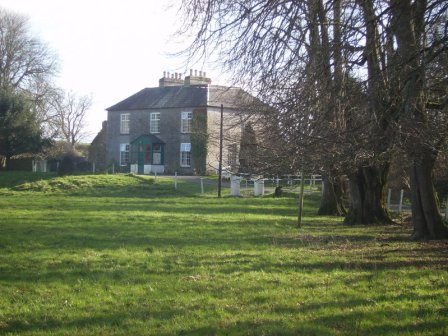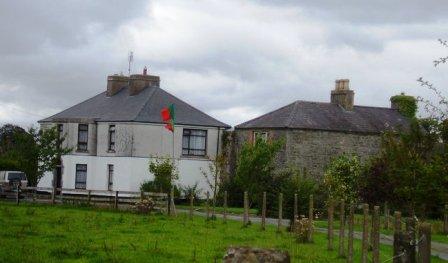Partry House
Houses within 5km of this house
Displaying 9 houses.
Houses within 5km of Partry House
Displaying 9 houses.
| House name | Description | |
|---|---|---|
| Creagh | The original house was situated beside the River Robe and was described in September 1836 by Robert Graham as a "nicely laid out cottage residence". Earlier, in 1786, Wilson refers to it as the seat of Mr. Cuff. Mary Louisa Cuffe was leasing the property from Colonel Charles Knox at the time of Griffiths Valuation, when it was valued at £32. A new house was built by Colonel Charles Knox in 1875, which became a tuberculosis sanatorium and a centre for the Agricultural Institute in the 20th century. James Cuff (recorded as Duff), of Creagh, near Ballinrobe, is mentioned as the proprietor of townlands in the parish of Ballynacourty, barony of Dunkellin, county Galway, at the time of the first Ordnance Survey in the 1830s. |

|
| Portroyal | In 1786 Wilson refers to Port Royal as the seat of Mr. Gildea. At the time of Griffith's Valuation, the townland was in the possession of James and Anthony Knox Gildea and the house was valued at £2 10s. The house is not shown on the 25-inch Ordnance Survey map of the 1890s. | |
| Cloonee | A house built circa 1760, sometimes known as Lakeview. It was occupied in the late 1770s by a member of the Browne family and from the early 19th century by the Blakes. Thomas Walsh was the occupier at the time of Griffith's Valuation. He held the property from Colonel Charles Knox. Cloonee was the home of William Creagh Burke in the early 20th century. The "Connaught Telegraph" of 9 March 1935 reported the sudden death of William C. Burke of Lakeview in the Main Street of Ballinrobe when a fair was taking place. The property passed by marriage to the Ruttledge family of Bloomfield. see www.clooneehouse.com/ |

|
| Springvale | Springvale was noted by Lewis as the home of Henry Joseph Blake in 1837. At the time of Griffith's Valuation the house was leased by Henry Blake from Joseph H. Bath and was valued at £8. A substantial corn mill in the townland, valued at £25, was leased by Henry Blake to Patrick Tierney at the same time. The house was later the residence of the Mayne family. It is still extant and occupied. The mill building is also still visible. |

|
| Cuslough | Lewis describes this house as formerly a 'seat of Lord Tyrawley and now of R.Livesay'. At the time of Griffith's Valuation it was occupied by Richard Livesay, leasing from Colonel Charles Knox, when the house was valued at £12. It stood close to the ruins of Cuslough Castle. | |
| Liskilleen | Built by Courtney Kenny in 1862. He was also the owner of the townland at the time of Griffith's Valuation when a herd's house existed there. It is still extant and occupied. |

|
| Brownstown | In 1786 Wilson refers to Brownstown as the seat of Mr. Browne. This house is shown on the 1st edition Ordnance Survey map but marked 'in ruins' on the later 25-inch edition. The townland was in the possession of George Browne at the time of Griffith's Valuation. The Irish Tourist Association file describes the house as a 3-storey T shaped plain residence, uninhabited for about 60 years. |

|
| Cornfield | Cornfield was the original Ruttledge home in the Hollymount area and continued to be lived in by family members until the 20th century, although it was replaced as the family's principal residence by Bloomfield. In 1786 Wilson refers to it as the seat of Mr. Ruttledge. In the mid 19th century it was the home of Thomas Ruttledge who married Jane Fair. He was leasing from Robert Ruttledge and the buildings were valued at £20. The existing dwelling is part of the original house, as are the ruins beside it. Local sources suggest that portions of the original house were demolished when the property was acquired by the Land Commission and some of the stone used to build houses in Hollymount village |

|
| Garriestown | This was a Walsh family home in the 19th century. At the time of Griffith's Valuation the house was leased by Thomas Walsh from Robert Rutledge when it was valued at £11. Garriestown is now a large farming enterprise and the house is still lived in. |

|

